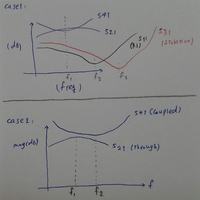bejing
Member level 2

Why best results of s21 and s11 don't occures in same frequency?
Hi dear friends,
I see this problem in some simulations of passive devices and transitions (more in ms line and stripline).
When im designing a coupler, the best results of return loss and isolation are not in the same frequency of the best results obtaining for insertion loss.
Also it may be occured for the insertion loss of through line and coupled line so the peak value and minimum value of these two graph are not in a same frequency.
Can anyone describe the reason of these phenomenon?
Thanks so very much.
Hi dear friends,
I see this problem in some simulations of passive devices and transitions (more in ms line and stripline).
When im designing a coupler, the best results of return loss and isolation are not in the same frequency of the best results obtaining for insertion loss.
Also it may be occured for the insertion loss of through line and coupled line so the peak value and minimum value of these two graph are not in a same frequency.
Can anyone describe the reason of these phenomenon?
Thanks so very much.



